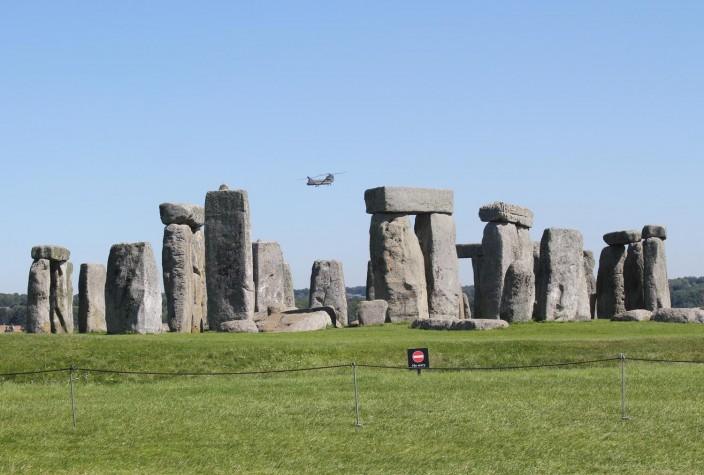Thursday 9th May
 Not many artists have taken on Stonehenge as a serious subject. The Eighteenth-Century antiquarian, William Stukeley, famously drew the stone circle from all angles in his survey of the ancient monument, but these studies were for research purposes and became the basis for the engraver’s plates illustrating Stukeley’s published works.
Not many artists have taken on Stonehenge as a serious subject. The Eighteenth-Century antiquarian, William Stukeley, famously drew the stone circle from all angles in his survey of the ancient monument, but these studies were for research purposes and became the basis for the engraver’s plates illustrating Stukeley’s published works.
At the turn of the 19th Century, William Turner made some sketches when he visited the stones and later produced a narrative watercolour depicting a catastrophe with sheep and shepherd.
In 1835, John Constable made a pleasing watercolour study of Stonehenge with a rainbow arching over the landscape, but he didn’t develop it into one of his series of larger oil paintings.
In the 20th Century, Henry Moore sketched the stones when visiting and, over this year that Mark and I have been tourists here, several other artists have made quick sketches, and maybe these will provide the essential information for studio works.
Local museums have many engravings and random studies done by various, often unknown artists through the centuries but, it has started to seem as if no one but Mark Anstee has been mad enough to spend this much time seriously drawing Stonehenge on location – until now.
At last, we have discovered another artist who chose to settle close to the stones, studying them for both artistic possibilities and archaeological significance and who produced a substantial body of work with Stonehenge as the focus.
The Victorian painter Edgar Barclay, born in London, 1842, travelled extensively in Germany and Italy to study with renowned masters of the day. He became an accomplished painter and engraver and enjoyed a successful career as part of a group of English painters calling themselves ‘The Etruscans’. Barclay’s wider interests extended to him becoming a distinguished pre-historian and, in the 1880s he turned his attentions from the antiquities of Italy to one of the most famous ancient landmarks of his homeland, Stonehenge.
He not only painted the subject prolifically but also wrote about it, publishing the substantial tome ‘Stonehenge and its Earthworks’ in 1895.
Barclay obviously had a great affinity with Stonehenge and wrote somewhat prophetically in the opening sentence of his description of the great stone circle:
“Although the first impression produced by Stonehenge on the visitor is often one of disappointment, this is usually due to its being first seen at a distance, when it appears but an insignificant object in the midst of the wide spreading chalk downs upon which it is placed, and which constitute what is known as Salisbury Plain; nevertheless, upon close inspection, when the size of the rocks which compose it is apparent, this unique relic of antiquity, by the sense of a grim earnestness, of energy and grandeur, which it never fails to convey, redeems its world wide reputation; and it is safe to predict that, with the course of time, the interest felt in it by the public will continue to increase rather than slacken.”
Attracting around a million visitors a year nowadays, we can say that Mr Barclay’s prediction was on the money.
The Young Gallery in Salisbury library houses Wiltshire’s substantial Edgar Barclay collection. Mark and I contacted the collection curator, Peter Riley, who very kindly made time today to pull some of the paintings out of storage and give us the opportunity to see Barclay’s Stonehenge works close up.
The paintings are delightfully traditional domestically sized oils, mainly framed in gold decorative plaster in the fashion of the day. They are rural romantic scenes depicting the landscape with sheep and shepherds, balmy skies and March hares.
Barclay painted as if the Industrial Revolution never happened and gives us an image of Stonehenge that remains an iconic romantic idyll. It strikes me, looking at Barclay’s paintings, that the current plans for redesigning the immediate landscape around the monument fits this Victorian image perfectly, or at least it does if you’re standing on the Cursus side of the Henge. Once the A303 comes into view, no one can be in any doubt that we’re firmly into the 21st Century.
Barclay has painted Stonehenge from different aspects, almost as a modern day tourist viewing the Circle from the prescribed walkway around it, but he has also painted it from within, siting his canvas on one occasion under the shadow of the then leaning Sarsen, the corrected upright Mark and I call ‘crow perch’.
In his paintings, Barclay honours Stonehenge in the same manner that the neo-classical schools honoured the more decorative antiquities of Italy and Greece, or the earlier Romantics honoured the ruins of church and state in northern Europe. There’s a yearning somehow, for a different understanding, for a connection with the past. But Stonehenge defiantly resists any attempts at prettification. Its artistry is in the honing of those massive lumps of rock, specifically and laboriously, to form part of a greater whole, the design of which still mystifies.
Barclay’s paintings aren’t ambitious, but they are touchingly honest.
You can see his paintings online here: